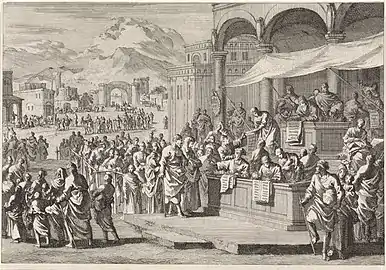The Census of Quirinius was a census of the Roman province of Judaea taken in 6 CE, upon its formation, by the governor of Roman Syria, Publius Sulpicius Quirinius. The census triggered a revolt of Jewish extremists (called Zealots) led by Judas of Galilee.
The Gospel of Luke uses the census to date the birth of Jesus, which the Gospel of Matthew places in the time of Herod the Great (who died between 5 BCE and 1 CE). Most critical scholars acknowledge that Luke is in error, while religious academics have attempted to explain the confusion with historically unverified claims.
Overview
Herod I (Herod the Great, c. 72 – 4 BCE), was a Roman client king whose territory included Judea. Upon his death, his kingdom was divided into three, each section ruled by one of his sons. In 6 CE, Emperor Augustus deposed Herod Archelaus, who had ruled the largest section, and converted his territory into the Roman province of Judaea.
In order to install an ad valorem property tax in the new province, Publius Sulpicius Quirinius, the legate (governor) of the province of Roman Syria starting in 6 CE,[1] was assigned to carry out a census in Judaea. This would record the names of the owners of taxable property, along with its value, for which they would be taxed.[2][3]
The census triggered a revolt of Jewish extremists (called Zealots) under the leadership of Judas of Galilee.[4] (Galilee itself was a separate territory under the rule of Herod Antipas.) Judas seems to have found the census objectionable because it ran counter to a biblical injunction (the traditional Jewish reading of Exodus 30:12) and because it would lead to taxes paid in heathen coins bearing an image of the emperor.[5]
Gospel of Luke
Contrary to the Gospel of Matthew, which places Jesus's birth in the time of Herod I,[6] the Gospel of Luke (2:1–5) correlates it with the census:
In those days a decree went out from Emperor Augustus that all the world should be registered. This was the first registration and was taken while Quirinius was governor of Syria. All went to their own towns to be registered. Joseph also went from the town of Nazareth in Galilee to Judea, to the city of David called Bethlehem, because he was descended from [David]. He went to be registered with Mary, to whom he was engaged and who was expecting a child.
Mainstream biblical scholars have acknowledged that the Gospel of Luke is erroneous.[7] Its author seems to have invoked the census as Joseph and Mary's motivation for departing "their own city"[8] of Nazareth, Galilee, for Bethlehem.[9] Additionally, the author may have wished to contrast Joseph and Mary's obedience to the Roman edict with the rebelliousness of the Zealots, and also to find a prophetic fulfilment of Psalm 87:6: "In the census of the peoples, [princes] will be born there."[9][lower-alpha 1][lower-alpha 2] (Luke and Matthew also give different accounts of the family's departure from Bethlehem.)[12][lower-alpha 3]
Scholars point out that there was no single census of the entire Roman Empire under Augustus and the Romans did not directly tax client kingdoms; further, no Roman census required that people travel from their own homes to those of their ancestors. A census of Judaea would not have affected Joseph and his family, who lived in Galilee under a different ruler; the revolt of Judas of Galilee suggests that Rome's direct taxation of Judaea was new at the time.[15] Catholic priest and biblical scholar Raymond E. Brown postulates that Judas's place of origin may have led the author of Luke to think that Galilee was subject to the census.[16] Brown also points out that in the Acts of the Apostles, Luke the Evangelist (the traditional author of both books) dates Judas's census-incited revolt as following Theudas's rebellion of four decades later.[16]
Religious defences
Early Christian apologist Justin Martyr (c. 100 – c. 165) claimed that Jesus's birth was recorded in the census.[17]
Some modern religious scholars have made attempts to reconcile Luke's error,[18] which according to Géza Vermes contradicts historical fact, assuming Luke refers to the Census of Quirinius.[19] Religious scholars have generally posited that an earlier census took place, invoking unproven claims. Ralph Martin Novak explains that both Quirinius's career and the names and dates of the governors are well documented and there is no time before 6 CE when Quirinius could have served an earlier term as governor of Syria.[1] Vermes describes attempts to defend the historicity of the biblical birth narratives as "exegetical acrobatics";[19] Novak points out that such views spring from biblical inerrancy, the belief that the Bible is without error.[20]
Specifically, Paul Barnett theorizes that a census unrelated to taxation took place before Quirinius's tenure.[18] Wayne Brindle argues that the gospel's translation is ambiguous and thus refers to an earlier census held during Herod the Great's reign as a result of the turbulent circumstances towards the end of his life; Brindle further argues that Quirinus held administrative power in the Syria region around that time as part of a dual governorship with Gaius Sentius Saturninus, the former holding military and the latter political power.[21] James A. Nollet asserts that Quirinius served two terms as governor of Syria and took two censuses in Judea, the earlier one being a universal census by Augustus allegedly taken in 2 BCE.[22] Dominican scholar Anthony Giambrone calls for "a more generous interpretation" of Luke to counter Augustan propaganda which purportedly could have been used to obscure a universal census of Roman regions conducted separately over a number of years.[23]: 350–351, 355
Gallery
 Pieter Bruegel the Elder, The Census at Bethlehem (1566), oil on wood panel, Royal Museums of Fine Arts of Belgium
Pieter Bruegel the Elder, The Census at Bethlehem (1566), oil on wood panel, Royal Museums of Fine Arts of Belgium Jan Luyken, Joseph and Mary taking the census (1700), etching and book print, Haarlem, Netherlands
Jan Luyken, Joseph and Mary taking the census (1700), etching and book print, Haarlem, Netherlands Jan Luyken, Joseph and Mary taking the census (1703), etching and book print, Haarlem, Netherlands
Jan Luyken, Joseph and Mary taking the census (1703), etching and book print, Haarlem, Netherlands
See also
References
Footnotes
- ↑ In place of the "princes" stated to be born in the Septuagint (Greek Old Testament), the English translation invokes the phrase "this one".[10]
- ↑ The Gospel of John portrays Christ's birth in Bethlehem as fulfilling a prophecy of Micah.[11]
- ↑ In Luke, Jesus's parents bring him first to Jerusalem and then to Nazareth.[13] In Matthew, they go to Nazareth to avoid Judaea because of Archelaus's appointment (4 BCE), then flee to Egypt.[12][14]
Citations
- 1 2 Novak 2001, pp. 293–298.
- ↑ Gruen 1996, pp. 156–157.
- ↑ Novak 2001, p. 290.
- ↑ Stern 1976, p. 274.
- ↑ Skarsaune 2008, p. 127.
- ↑ Matthew 2:16–18
- ↑ Novak 2001, p. 292; Brown 1977, p. 17.
- ↑ Luke 2:39
- 1 2 Brown 1978, pp. 17–19.
- ↑ Brown 1978, p. 19.
- ↑ Muss-Arnolt 1897.
- 1 2 Brown 1978, p. 17.
- ↑ Luke 2:22–40
- ↑ Matthew 2:23
- ↑ Novak 2001, pp. 293–298; Brown 1977, pp. 552–553; Brown 1978, pp. 17.
- 1 2 Brown 1977, p. 413.
- ↑ Justin Martyr. . Translated by Philip Schaff – via Wikisource.
Now there is a village in the land of the Jews, thirty-five stadia from Jerusalem, in which Jesus Christ was born, as you can ascertain also from the registers of the taxing made under [Quirinius], your first procurator in Judæa.
- 1 2 Brown 1977, p. 552.
- 1 2 Vermes 2010.
- ↑ Novak 2001, pp. 296–297.
- ↑ Brindle, Wayne (1984). "The Census and Quirinus: Luke 2:2". Journal of the Evangelical Theological Society. 27 (1): 52. Retrieved 27 May 2023.
- ↑ Nollet, James A. (December 2012). "Astronomical and Historical Evidence for Dating the Nativity in 2 BC" (PDF). Perspectives on Science and Christian Faith. 64 (4).
- ↑ Giambrone, Anthony (2021). "Augustus as Censor and Luke's Worldwide Enrollment: Roman Propaganda and Lukan Theology from the Margins". Revista Bíblica. 83 (3–4): 337–362. doi:10.47182/rb.83.n3-4-2021287. ISSN 2683-7153.
Bibliography
- Brown, Raymond E. (1977). The Birth of the Messiah: A Commentary on the Infancy Narratives in Matthew and Luke. Doubleday & Company. ISBN 9780385059077.
- Brown, Raymond E. (1978). An Adult Christ at Christmas: Essays on the Three Biblical Christmas Stories. Liturgical Press. ISBN 9780814609972.
- Edwards, James R. (2015). The Gospel of Luke. Eerdmans. ISBN 9780802837356.
- Gruen, Erich S. (1996). "The Expansion of the Empire Under Augustus". In Bowman, Alan K.; Champlin, Edward; Lintott, Andrew (eds.). The Cambridge Ancient History. Vol. 10. Cambridge University Press. ISBN 9780521264303.
- Marucci, Corrado (1996). "Storia e amministrazione romana nel Nuovo Testamento". In Haase, Wolfgang; Temporini, Hildegard (eds.). Aufstieg und Niedergang der römischen Welt/Rise and decline of the Roman world (in Italian). Vol. 2. Berlin, Boston: De Gruyter. ISBN 9783110830880.
- Muss-Arnolt, W. (1897). "Helps to the Study of the Earlier Prophets". The Biblical World. 9 (6): 443–456. doi:10.1086/472091. ISSN 0190-3578. JSTOR 3140020. S2CID 145684600.
- Novak, Ralph Martin (2001). Christianity and the Roman Empire: Background Texts. Continuum International. ISBN 9780567018403.
- Schäfer, Nadja (2000). Die Einbeziehung der Provinzialen in den Reichsdienst in augusteischer Zeit (in German). Stuttgart: Franz Steiner. ISBN 978-3-515-07723-1.
- Skarsaune, Oskar (2008). In the Shadow of the Temple: Jewish Influences on Early Christianity. InterVarsity Press. ISBN 9780830828449.
- Stern, M. (1976). "The Period of the Second Temple". In Malamat, Abraham; Tadmor, Hayim (eds.). A History of the Jewish People. Harvard University Press. ISBN 9780674397316.
- Vermes, Géza (2010). Jesus: Nativity - Passion - Resurrection. Penguin. ISBN 9780141957449.
- Zeichmann, Christopher B. (2018). "Text sometimes related to the Augustan cohort of Acts 28 (i.e., cohors Augusta)". Database of Military Inscriptions and Papyri of Early Roman Palestine. Retrieved 28 October 2022.
